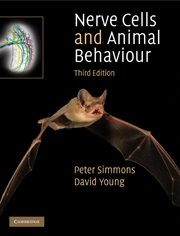Book contents
- Frontmatter
- Contents
- Preface
- 1 Organisation of animal behaviour and of brains: feeding in star-nosed moles and courtship in fruit flies
- 2 Signals in nerve cells: reflexes in mammals and insects
- 3 Neuronal mechanisms for releasing behaviour: predator and prey – toad and cockroach
- 4 Neuronal pathways for behaviour: startle behaviours and giant neurons in crayfish and fish
- 5 Eyes and vision: sensory filtering and course control in insects
- 6 Sensory maps: hunting by owls and bats
- 7 Programmes for movement: how nervous systems generate and control rhythmic movements
- 8 Changes in nerve cells and behaviour: learning in bees and rats; swarming in locusts
- 9 Nerve cells and animal signalling: songs of crickets, electric fish and birds
- References
- Index
- References
2 - Signals in nerve cells: reflexes in mammals and insects
Published online by Cambridge University Press: 05 August 2012
- Frontmatter
- Contents
- Preface
- 1 Organisation of animal behaviour and of brains: feeding in star-nosed moles and courtship in fruit flies
- 2 Signals in nerve cells: reflexes in mammals and insects
- 3 Neuronal mechanisms for releasing behaviour: predator and prey – toad and cockroach
- 4 Neuronal pathways for behaviour: startle behaviours and giant neurons in crayfish and fish
- 5 Eyes and vision: sensory filtering and course control in insects
- 6 Sensory maps: hunting by owls and bats
- 7 Programmes for movement: how nervous systems generate and control rhythmic movements
- 8 Changes in nerve cells and behaviour: learning in bees and rats; swarming in locusts
- 9 Nerve cells and animal signalling: songs of crickets, electric fish and birds
- References
- Index
- References
Summary
Individual neurons receive and transmit information in the form of small electrical signals. Most significantly, they also integrate the signals they receive, combining inputs from different sources and over time to determine their own outputs. Integration enables neurons to work together and form networks that perform the kinds of operations needed to control behaviour, such as sensory filtering or motor pattern generation. In this chapter we first provide the information about how neurons work that is needed to understand the later chapters in the book, starting with a description of how a simple sense organ works. We then illustrate the ways in which neurons receive and integrate signals in simple behavioural responses in two different animals: a mammal, and an insect. Sometimes these movements are called reflexes; they are almost automatic reactions to simple stimuli that affect a limited part of the body, and involve pathways of only a few neurons. They illustrate very well the basic principles of neuronal physiology.
The shortest neuronal pathways in arthropods and vertebrates include just two connected neurons: a sensory receptor, and a motor neuron. Sensory receptors are cells specialised to receive a particular form of environmental stimulus – such as light energy, mechanical movement, or chemical molecules in an odour – and to respond with an electrical signal. Some sensory receptors provide information about positions or movements of an animal's body parts, and receptors that do this are called proprioceptors.
- Type
- Chapter
- Information
- Nerve Cells and Animal Behaviour , pp. 21 - 43Publisher: Cambridge University PressPrint publication year: 2010



